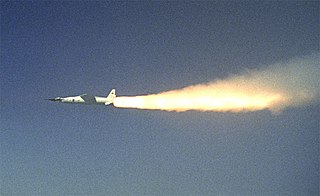
A scramjet is a variant of a ramjet airbreathing jet engine in which combustion takes place in supersonic airflow. As in ramjets, a scramjet relies on high vehicle speed to compress the incoming air forcefully before combustion, but whereas a ramjet decelerates the air to subsonic velocities before combustion using shock cones, a scramjet has no shock cone and slows the airflow using shockwaves produced by its ignition source in place of a shock cone. This allows the scramjet to operate efficiently at extremely high speeds.

The NASA X-43 was an experimental unmanned hypersonic aircraft with multiple planned scale variations meant to test various aspects of hypersonic flight. It was part of the X-plane series and specifically of NASA's Hyper-X program. It set several airspeed records for jet aircraft. The X-43 is the fastest jet-powered aircraft on record at approximately Mach 9.6.
The Australian Space Research Institute (ASRI) was formed 1991 with the merger of the AUSROC Launch Vehicle Development Group at Monash University, Melbourne and the Australian Space Engineering Research Association (ASERA).

The Boeing X-51 Waverider is an unmanned research scramjet experimental aircraft for hypersonic flight at Mach 5 and an altitude of 70,000 feet (21,000 m). The aircraft was designated X-51 in 2005. It completed its first powered hypersonic flight on 26 May 2010. After two unsuccessful test flights, the X-51 completed a flight of over six minutes and reached speeds of over Mach 5 for 210 seconds on 1 May 2013 for the longest duration powered hypersonic flight.
Scramjet programs refers to research and testing programs for the development of supersonic combustion ramjets, known as scramjets. This list provides a short overview of national and international collaborations, and civilian and military programs. The USA, Russia, India, and China (2014), have succeeded at developing scramjet technologies.

Lockheed L-301 was an experimental air-breathing hypersonic aircraft project. It was developed by the NASA and United States Air Force (USAF) organization National Hypersonic Flight Research Facility, with Skunk Works as the prime contractor. In January 1977, the program was "tentatively scheduled to operate two vehicles for eight years and to conduct 100 flights per vehicle." NASA discontinued work on L-301 and NHRF in September 1977 due to budget constraints and lack of need.
The Hy-V Scramjet Flight Experiment is a research project being led by the University of Virginia, the goal of which is to better understand dual-mode scramjet combustion by analyzing and comparing wind tunnel and flight data. The work is being conducted with industrial, academic and government collaborators.

LAPCAT was a 36-month European FP6 study to examine ways to produce engines for a Mach number 4-8 hypersonic flight aircraft. The project ended in April 2008. It was funded by the European Commission research and development fund, and cost 7 million euros.

The Tupolev Tu-2000 was a planned hypersonic flight experimental aircraft designed by the Tupolev design bureau. It was intended to test technologies for a single-stage-to-orbit aerospaceplane and also the Tupolev Tu-360 intercontinental bomber.

Hypersonic flight is flight through the atmosphere below altitudes of about 90 km at speeds greater than Mach 5, a speed where dissociation of air begins to become significant and high heat loads exist. Speeds of Mach 25+ have been achieved below the thermosphere as of 2020.

Reusable Launch Vehicle–Technology Demonstration Programme is a series of technology demonstration missions that has been conceived by the Indian Space Research Organisation (ISRO) as a first step towards realising a Two Stage To Orbit (TSTO) re-usable launch vehicle.
HyShot is a research project of The University of Queensland, Australia Centre for Hypersonics, to demonstrate the possibility of supersonic combustion under flight conditions using two scramjet engines, one designed by The University of Queensland and one designed by QinetiQ.

The HSTDV is an unmanned scramjet demonstration aircraft for hypersonic speed flight. It is being developed as a carrier vehicle for hypersonic and long-range cruise missiles, and will have multiple civilian applications including the launching of small satellites at low cost. The HSTDV program is being run by the Defence Research and Development Organisation (DRDO).

The Mobile Rocket Base, abbreviated MORABA, is a department of the DLR Space Operations and Astronaut Training in Oberpfaffenhofen near Munich. Since the 1960s, the MORABA has performed scientific high altitude research missions with unmanned rockets and balloons, and has developed the required mechanical and electrical systems. Their operational areas include upper atmosphere research, microgravity research, astronomy, geophysics, materials science, as well as hypersonic research.

A hypersonic glide vehicle (HGV) is a type of warhead for ballistic missiles that can maneuver and glide at hypersonic speed. It is used in conjunction with ballistic missiles to significantly change their trajectories after launch. Conventional ballistic missiles follow a predictable ballistic trajectory and are vulnerable to interception by the latest anti-ballistic missile (ABM) systems. The in-flight maneuverability of HGVs makes them unpredictable, allowing them to effectively evade air defenses. Hypersonic glide vehicles are currently the subject of an arm race.

Kholod (Холод) is the name of an experimental Russian rocket project. The hypersonic rocket uses a scramjet engine and was created to exceed Mach 5.75. The prototype consists of a Soyuz TMKB with liquid hydrogen and modified fillings from the SA-5 Gammon missiles. The entire rocket, including the four booster rockets, is 12 metres (39 ft) long and 750 millimetres (30 in) in diameter. The project led to other Russian hypersonic rockets like the Igla rocket craft and the Yu-71 boost-glide warhead.

Saenger or Sänger was a West German concept design for a two-stage-to-orbit spaceplane. It is named after Eugen Sänger, who had been a key figure in the development of the concept for aerospace company Junkers.
The Austral Launch Vehicle (ALV) is a concept for a re-usable launch vehicle first stage. It would use fly-back UAV boosters to reduce overall launch costs.

RLV-TD or Reusable Launch Vehicle Technology Demonstrator is India's first uncrewed flying testbed developed for the Indian Space Research Organisation (ISRO)'s Reusable Launch Vehicle Technology Demonstration Programme started in 2012. It is a scaled down prototype of an eventual two-stage-to-orbit (TSTO) reusable launch vehicle.
Hypersonix Launch Systems is an Australian space startup developing scramjet and scramjet-based access-to-space technology. In particular, the company is focused on reusable, "green-fuelled" launch technology. It's an aerospace engineering, design and build company specialising In hypersonic vehicle and scramjet engines to provide sustainable affordable access to space.












